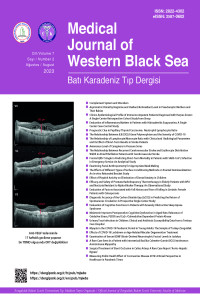Coronavirüs Hastalığının Halk Sağlığı Etkisinin Ölçülmesi 2019: Pandemi Zamanlarında Sağlık Hizmetlerinde Yeni Bir Perspektif
Abstract
Yakın zamanda ortaya çıkan Şiddetli Akut Solunum Sendromu CoronaVirus 2'nin (SARS-CoV-2)
patlak vermesinden bu yana, halk sağlığı endişeleri, 2019 Koronavirüs Hastalığı (Covid-19) hakkında
çok fazla veri toplanmasına neden olmuştur. Pandeminin ilerleyişine ilişkin en önemli ölçütler,
salgına ilişkin kapsamlı bir şekilde toplanan kayıtlı vakalar ve bildirilen ölüm veri setleridir. Hastalığı
değerlendirmek veya öngörmek için sadece morbidite ve mortalite sayılarına güvenmenin yetersiz
olduğu ortaya çıkmıştır. Halk sağlığı otoriteleri ve resmi kuruluşlar için çok daha faydalı olması için
bu verilerin önemli bir uzantısının değiştirilmesi önerilmektedir. Böylesine yıkıcı bir pandemiyi ölçmek
için kolayca anlaşılabilecek ve uygulanabilecek niceliksel ölçütlerin pratik bir kullanımını benimsemek
makul olacaktır. Gözlenebilecek başlıca üç parametre, salgının büyüklüğünü, zamanla değişim hızını
ve farklı aralıklarla morbidite ve mortalite oranlarındaki farkın stabilite derecesini değerlendirmeyi içerir.
Ek olarak, kümülatif günlük veri setlerine göre salgının modelini tanımlamak için en iyi eğri uydurma
yaklaşımını kullanan ampirik modelleme uygulaması gerçekleştirilebilir.
Keywords
References
- 1. Eissa DE, Rashed ER, Eissa ME. A Study of Morbidity and Mortality from COVID-19 in India. SciMedicine Journal. 2022;4(1):25-38.
- 2. Choudhary OP, Saied AA, Ali RK, Maulud SQ. Russo-Ukrainian war: An unexpected event during the COVID-19 pandemic. Travel Medicine and Infectious Disease. 2022;48:102346.
- 3. Rashed ER, Eissa ME. Global assessment of morbidity and mortality pattern of CoVID-19: Descriptive statistics overview. Iberoamerican Journal of Medicine. 2020;2(2):68-72.
- 4. OCHA HDX v1.67.4 PY3 Welcome - Humanitarian Data Exchange. https://data.humdata.org/1. Welcome - Humanitarian Data Exchange [Internet]. Humdata.org. 2019. Available from: https://data.humdata.org/
- 5. Eissa ME, Rashed ER, Eissa DE. Covid-19 kinetics based on reported daily incidence in highly devastated geographical region: A unique analysis approach of epidemic. Universal Journal of Pharmaceutical Research 2022;7(6):58-62.
- 6. Eissa M, Rashed E. Descriptive Analysis of Coronavirus Disease Cases Based on Geographical Distribution in Canadian Provinces/Territories: Statistical Investigation into Epidemiological Pattern. Academia Letters. 2022:2.
- 7. Cao L, Liu Q. COVID-19 modeling: A review. medRxiv. 2022:2022-08.
- 8. Kumar P, Singh RK, Nanda C, Kalita H, Patairiya S, Sharma YD, Rani M, Bhagavathula AS. Forecasting COVID-19 impact in India using pandemic waves Nonlinear Growth Models. MedRxiv 2020:2020-3.
- 9. Eissa ME, Rashed ER, Eissa DE. Implementation of the Pareto principle in focus group generation based on global coronavirus disease morbidity and mortality rates. Highlights in BioScience 2022;5.
- 10. Eissa M. Modeling of COVID-19 major outbreak wave through statistical software: quantitative risk evaluation and description analysis. ESTÜDAM Halk Sağlığı Dergisi 2022;7(1):145-161.
Measuring Public Health Effect of Coronavirus Disease 2019: A Novel Perspective in Healthcare in Pandemic Times
Abstract
Since the spark of the recent Severe Acute Respiratory Syndrome CoronaVirus 2 (SARS-CoV-2), public
health concerns have motivated the accumulation of a vast amount of data about the Coronavirus
Disease 2019 (COVID-19). The most important metrics for the pandemic progression are the recorded
cases and reported deaths datasets which were comprehensively collected pertaining to the outbreak.
The reliance on the census of morbidity and mortality lists solely appeared to be inadequate to assess
or forecast the disease. It is proposed that a significant extension of this data should be amended to be
much more useful for public health authorities and official organizations. It would be plausible to adopt
a practical use of quantitative metrics that could be easily understandable and applied for measuring
such a catastrophic pandemic. Three parameters that might be observed primarily involve assessing
the outbreak magnitude, rate of change with time and the degree of stability of the difference in the rate
of morbidities and mortalities at different intervals. In addition, empirical modeling implementation using
the curve-fitting approach could be conducted to describe the pattern of the epidemic according to the
cumulative daily datasets
Keywords
References
- 1. Eissa DE, Rashed ER, Eissa ME. A Study of Morbidity and Mortality from COVID-19 in India. SciMedicine Journal. 2022;4(1):25-38.
- 2. Choudhary OP, Saied AA, Ali RK, Maulud SQ. Russo-Ukrainian war: An unexpected event during the COVID-19 pandemic. Travel Medicine and Infectious Disease. 2022;48:102346.
- 3. Rashed ER, Eissa ME. Global assessment of morbidity and mortality pattern of CoVID-19: Descriptive statistics overview. Iberoamerican Journal of Medicine. 2020;2(2):68-72.
- 4. OCHA HDX v1.67.4 PY3 Welcome - Humanitarian Data Exchange. https://data.humdata.org/1. Welcome - Humanitarian Data Exchange [Internet]. Humdata.org. 2019. Available from: https://data.humdata.org/
- 5. Eissa ME, Rashed ER, Eissa DE. Covid-19 kinetics based on reported daily incidence in highly devastated geographical region: A unique analysis approach of epidemic. Universal Journal of Pharmaceutical Research 2022;7(6):58-62.
- 6. Eissa M, Rashed E. Descriptive Analysis of Coronavirus Disease Cases Based on Geographical Distribution in Canadian Provinces/Territories: Statistical Investigation into Epidemiological Pattern. Academia Letters. 2022:2.
- 7. Cao L, Liu Q. COVID-19 modeling: A review. medRxiv. 2022:2022-08.
- 8. Kumar P, Singh RK, Nanda C, Kalita H, Patairiya S, Sharma YD, Rani M, Bhagavathula AS. Forecasting COVID-19 impact in India using pandemic waves Nonlinear Growth Models. MedRxiv 2020:2020-3.
- 9. Eissa ME, Rashed ER, Eissa DE. Implementation of the Pareto principle in focus group generation based on global coronavirus disease morbidity and mortality rates. Highlights in BioScience 2022;5.
- 10. Eissa M. Modeling of COVID-19 major outbreak wave through statistical software: quantitative risk evaluation and description analysis. ESTÜDAM Halk Sağlığı Dergisi 2022;7(1):145-161.
Details
| Primary Language | English |
|---|---|
| Subjects | Health Care Administration |
| Journal Section | Letter to Editors |
| Authors | |
| Publication Date | August 31, 2023 |
| Acceptance Date | August 18, 2023 |
| Published in Issue | Year 2023 Volume: 7 Issue: 2 |

